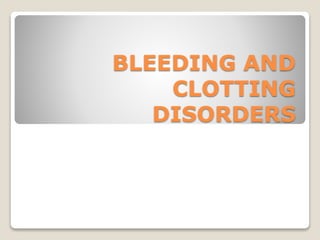
BLEEDING AND CLOTTING DISORDERS: CAUSES AND TESTS
- 2. LEARNING OUTCOMES ENUMERATE BLEEDING DISORDERS ENUMERATE THROMBOEMBOLIC CONDITIONS IN THE HUMAN BEING ENUMERATE BLOOD COAGULATION TESTS
- 3. Decreased Prothrombin, Factor VII, Factor IX, and Factor X Caused by Vitamin K Deficiency Diseases of the liver such as hepatitis, cirrhosis, and acute yellow atrophy can sometimes depress the clotting system so greatly that the patient develops a severe tendency to bleed.
- 4. Conditions That Cause Excessive Bleeding in Human Beings Bleeding caused by (1) Vitamin K deficiency (2) Hemophilia (3) Thrombocytopenia (platelet deficiency).
- 5. Another cause of depressed formation of clotting factors by the liver is vitamin K deficiency. Vitamin K is necessary for liver formation of five of the important clotting factors: prothrombin, Factor VII, Factor IX, Factor X, and protein C.
- 6. APPLIED Thus, liver disease often causes decreased production of prothrombin and some other clotting factors both because of poor vitamin K absorption and because of the diseased liver cells. Because of this, vitamin K is injected into all surgical patients with liver disease or with obstructed bile ducts before performing the surgical procedure. Ordinarily, if vitamin K is given to a deficient patient 4 to 8 hours before the operation and the liver parenchymal cells are at least one-half normal in function, sufficient clotting factors will be produced to prevent excessive bleeding during the operation.
- 7. Hemophilia Hemophilia is a bleeding disease that occurs almost exclusively in males. In 85 per cent of cases, it is caused by an abnormality or deficiency of Factor VIII; this type of hemophilia is called hemophilia A or classic hemophilia.
- 8. Factor VIII has two active components, a large component with a molecular weight in the millions and a smaller component with a molecular weight of about 230,000. The smaller component is most important in the intrinsic pathway for clotting, and it is deficiency of this part of Factor VIII that causes classic hemophilia. Another bleeding disease with somewhat different characteristics, called von Willebrand’s disease, results from loss of the large component
- 9. When a person with classic hemophilia experiences severe prolonged bleeding, almost the only therapy that is truly effective is injection of purified Factor VIII. The cost of Factor VIII is high Its availability is limited because it can be gathered only from human blood and only in extremely small quantities
- 10. Thrombocytopenia PURPURA They measure 0.3–1 cm (3–10 mm), whereas petechiae measure less than 3 mm, and ecchymoses greater than 1 cm.
- 11. ITP
- 12. Thromboembolic Conditions in the Human Being An abnormal clot that develops in a blood vessel is called a thrombus. Once a clot has developed, continued flow of blood past the clot is likely to break it away from its attachment and cause the clot to flow with the blood; such freely flowing clots are known as emboli.
- 13. Cause of Thromboembolic Conditions (1) Any roughened endothelial surface of a vessel—as may be caused by arteriosclerosis, infection, or trauma—is likely to initiate the clotting process. (2)Blood often clots when it flows very slowly through blood vessels, where small quantities of thrombin and other procoagulants are always being formed
- 14. Use of t-PA in Treating Intravascular Clots. Genetically engineered t-PA (tissue plasminogen activator) is available. When delivered directly to a thrombosed area through a catheter, it is effective in activating plasminogen to plasmin, which in turn can dissolve some intravascular clots.
- 15. Femoral Venous Thrombosis and Massive Pulmonary Embolism Because clotting almost always occurs when Blood flow is blocked for many hours in any vessel of the body The immobility of patients confined to bed The practice of propping the knees with pillows often causes intravascular clotting because of blood stasis in one or more of the leg veins for hours at a time.
- 16. Disseminated Intravascular Coagulation Occasionally the clotting mechanism becomes activated in widespread areas of the circulation, giving rise to the condition called disseminated intravascular coagulation. This often results from the presence of large amounts of traumatized or dying tissue in the body that releases great quantities of tissue factor into the blood.
- 17. This occurs especially in patients with widespread septicemia, in which either circulating bacteria or bacterial toxins— especially endotoxins— activate the clotting mechanisms. Plugging of small peripheral vessels greatly diminishes delivery of oxygen and other nutrients to the tissues—a situation that leads to or exacerbates circulatory shock. It is partly for this reason that septicemic shock is lethal in 85 per cent or more of patients
- 19. Bleeding Time When a sharp-pointed knife is used to pierce the tip of the finger or lobe of the ear, bleeding ordinarily lasts for 1 to 6 minutes. The time depends largely on the depth of the wound and the degree of hyperemia in the finger or ear lobe at the time of the test. Lack of any one of several of the clotting factors can prolong the bleeding time, but it is especially prolonged by lack of platelets.
- 20. Clotting Time Unfortunately, the clotting time varies widely, depending on the method used for measuring it, so it is no longer used in many clinics. Instead, measurements of the clotting factors themselves are made, using sophisticated chemical procedures.
- 21. Prothrombin Time Blood removed from the patient is immediately oxalated so that none of the prothrombin can change into thrombin.Then, a large excess of calcium ion and tissue factor is quickly mixed with the oxalated blood. The excess calcium nullifies the effect of the oxalate, and the tissue factor activates the prothrombin-to thrombin reaction by means of the extrinsic clotting pathway. The time required for coagulation to take place is known as the prothrombin time. The shortness of the time is determined mainly by prothrombin concentration. The normal prothrombin time is about 12 seconds.